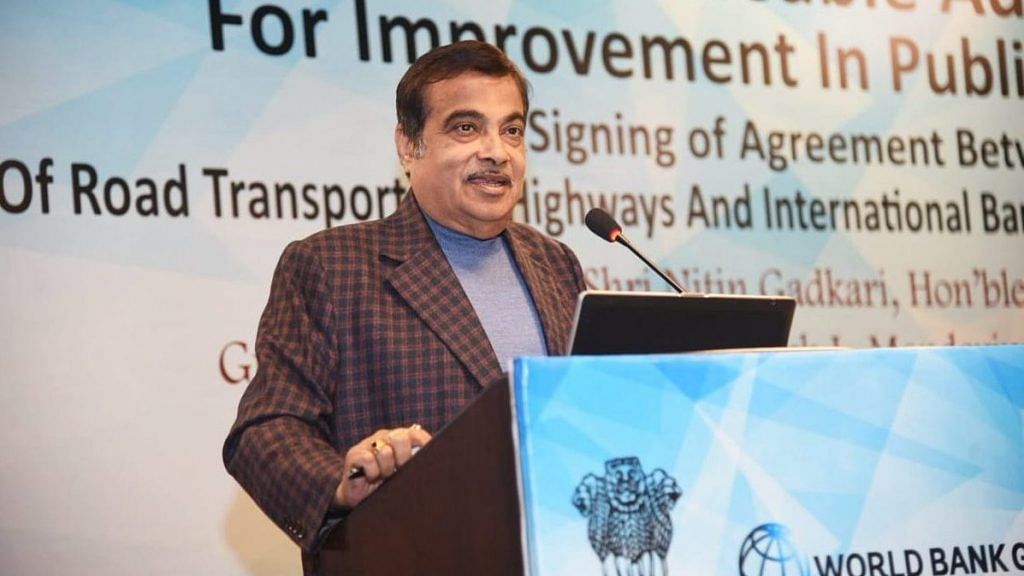New Delhi: Alarmed at the rate at which Union Road Transport & Highways Minister Nitin Gadkari was declaring state roads as National Highways — and the likely financial implications for the central government — the Prime Minister’s Office (PMO) has stepped in to review the whole process.
Senior government officials told ThePrint that the PMO has also put on hold all new announcements as well as “in-principle approvals” already given to several state roads until a high-level inter-ministerial panel headed by Cabinet Secretary P.K. Sinha approves a new set of comprehensive guidelines.
“The PMO stepped in as it was felt that there is a need for some fiscal discipline. The road ministry has bitten off more than it can chew. It will be a burden on the exchequer at a time when the ministry is facing fund constraints,” said one senior government official who did not want to be named.
Once a state road is declared a national highway, its maintenance, upgradation and expansion becomes the Centre’s responsibility.
After the NDA government came to power in 2014, the road transport & highways ministry approved approximately 72,000 km of state roads to be declared as national highways. Of this, 19,000 km have been notified, while the other 53,000 km have been given “in-principle approval”.
For 2019-20, the road transport & highways ministry has projected a revenue deficit of over Rs 37,000 crore to the finance ministry.
According to the ministry, the current per-kilometre cost of developing a two-lane highway is anywhere between Rs 11.5 crore to Rs 12 crore, while for a four-lane highway, it is approximately Rs 30 crore per km.
Following a meeting in March, Nripendra Misra, Principal Secretary to PM Narendra Modi, had also directed the expenditure secretary to conduct an inquiry into the role played by the road transport ministry’s financial advisers in deviating from the existing system of declaring national highways. The probe is on.
Also read: India’s national highways have ‘black spots’ and they are dangerous
Current system
States want more and more roads to be declared national highways as it takes way the financial burden of maintenance and upgradation. The central ministry also benefits as the addition of these roads means the national highway network grows.
From 91,287 km in March 2014, the total length of national highways has increased to 1,32,500 km as of 22 July 2019, Gadkari had told Parliament. This figure does not include the 53,000 km of state roads, which were given “in-principle” approval to be declared as national highways, and the 19,000 km that were notified as NH.
Currently, there are no robust guidelines for declaring state roads as national highways.
When states used to send proposals for declaring a state road as a national highway, the ministry used to arrive at a decision based on 11 criteria, which were very general in nature.
The criteria include roads running through the length/breadth of the country, connecting adjacent countries, national capitals with state capitals, major ports, non-major ports, large industrial centres or tourist centres, roads meeting very important strategic requirements in hilly and isolated area, arterial roads which enable sizeable reduction in travel distance and achieve substantial economic growth thereby, roads which help opening up large tracts of backward areas and hilly regions (other than strategically important ones), etc.
Until 2014, an inter-ministerial group comprising the Planning Commission, and the finance and road transport & highways ministries used to discuss and decide if the road was fit to be declared a national highway.
“In the absence of well-defined scientific norms, the decision to declare a state road as NH was being done arbitrarily. Many roads, which otherwise would not have qualified, were getting approved. This was making a dent in highway finances, especially at a time when the ministry is facing fund constraint on account of private developers shying away from bidding for projects,” said another official.
New norms being finalised
After the PMO’s intervention last year, a committee of secretaries (CoS) headed by Cabinet Secretary P.K. Sinha was formed to finalise the new norms. The other members of the CoS include Niti Aayog CEO Amitabh Kant, Expenditure Secretary Girish Chandra Murmu and Road Transport & Highways Secretary Sanjeev Ranjan.
Between September 2018 and now, the CoS has met seven times to discuss the issue and finalise the guidelines, with the last meeting held on 7 August.
“The new norms are being worked out. They will factor in various criteria, including the number of vehicles plying per day on the road before it is declared an NH,” said the first government official quoted above.
Also read: Nitin Gadkari ticks off national infra fund over delay, says many others ready to fund govt
